
You may think New Mexico is mostly desert but it really has a varied landscape including some beautiful lakes. Navajo Lake is in the far northern part of the state on the border with Colorado. In southern New Mexico is the largest lake in the state, Elephant Butte Lake. You can go scuba diving in the Blue Hole in Santa Rosa, NM which gets to be 80 feet deep! Then there are the legendary Bottomless Lakes – a series of nine sinkholes filled with green-blue waters. Are they really bottomless? You can’t get much deeper than “bottomless” but let’s just say that is an exaggeration, so which lake in New Mexico is really the deepest? Let’s take a look at the deepest lake in New Mexico.
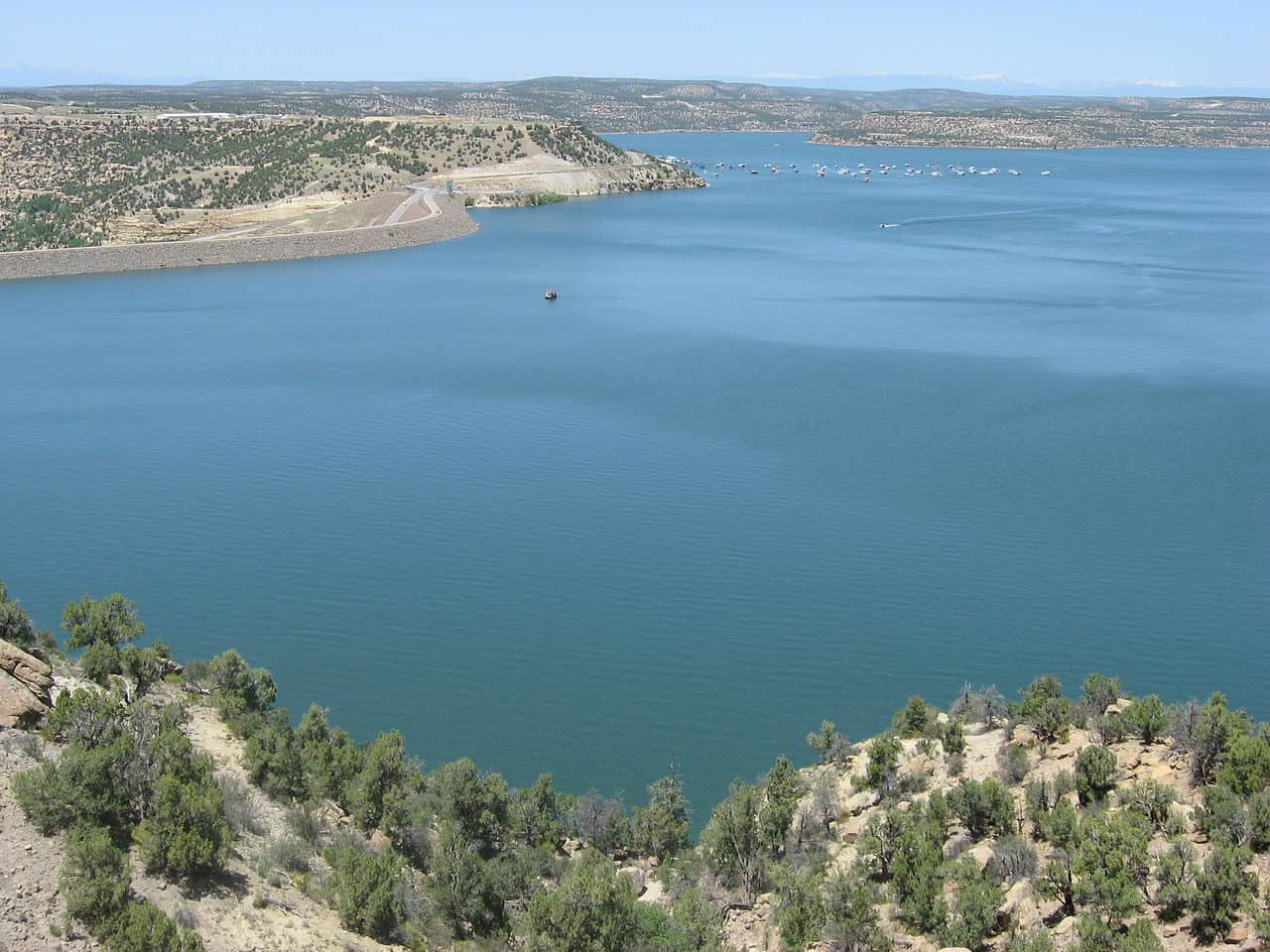
Navajo Lake is a reservoir in Northern New Mexico that crosses into Colorado.
©Timthefinn at English Wikipedia / This work has been released into the public domain by its author, Timthefinn at English Wikipedia. This applies worldwide. – License
What Is The Deepest Lake In New Mexico?
The deepest lake in New Mexico is Navajo Lake. This reservoir is in northern New Mexico on the San Juan River. A tail of the lake crosses over into neighboring Colorado. Navajo Lake State Park is located around the lake and has multiple campgrounds to enjoy the beautiful lake and its surroundings. The lake is a popular recreational area for boating, windsurfing, swimming, and fly fishing.
There are two separate marinas where you can rent fishing boats to find the best fishing hole on the lake or pontoon boats for a leisurely afternoon in the sun. At the Navajo Lake Marina, you can rent a 36’ Fun Ship that can fit 22 people and includes 2 waterslides, restrooms, and a grill. Many options can be found for getting out on the water with friends and family for an epic “day at the lake”.
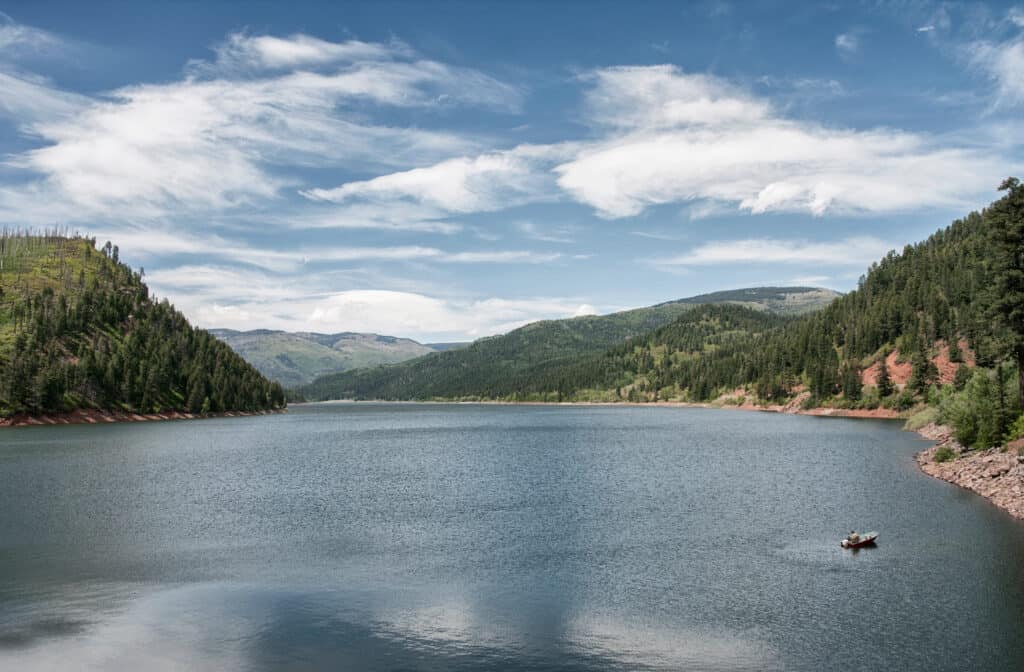
Navajo Lake is the deepest lake in New Mexico reaching 395 feet in depth near the Navajo Dam.
©Navajo Lake, New Mexico/Shutterstock.com
How Deep Is The Deepest Lake In New Mexico?
The deepest lake in New Mexico is 395 feet deep. Navajo Lake is nearly 400 feet deep which, for comparison, is about 10 school buses lined up in a row. Now that is pretty deep! The deepest part of the lake is near the Navajo Dam. The dam was built in the 1960s to help with flood control in the area and to manage the water supply.
Where is Navajo Lake Located on a Map?
Navajo Lake is located in New Mexico, and it is a popular destination for outdoor enthusiasts. To get there, visitors can take Highway 511 from Aztec or Farmington. The lake itself is situated about 30 miles northeast of Farmington.
On a map, Navajo Lake is located near the border between New Mexico and Colorado. It is part of the larger San Juan River system, which runs through Colorado, New Mexico, Utah, and Arizona. The lake covers over 15,000 acres and has more than 150 miles of shoreline.
Is There A Ghost Town Buried Under Navajo Lake?
Yes! Not just one ghost town but four. There were four communities that had settled in the area along the San Juan River that later became Navajo Lake. While it made sense for greater New Mexico and future water conservation and flood control, you have to think about the generations of families that made their life on these lands. These families were forced to relocate when they didn’t want to.
The towns of Los Arboles, Rose, Los Pinos, and Los Martinez all had to relocate and the remains of their towns are at the bottom of Navajo Lake. It is estimated that nearly 200 families had to relocate to accommodate the new dam and lake in the late 1950s. This isn’t a unique story for New Mexico, as many manmade reservoirs in the US displaced communities, but it still had a significant effect on the families that grew up along the San Juan.
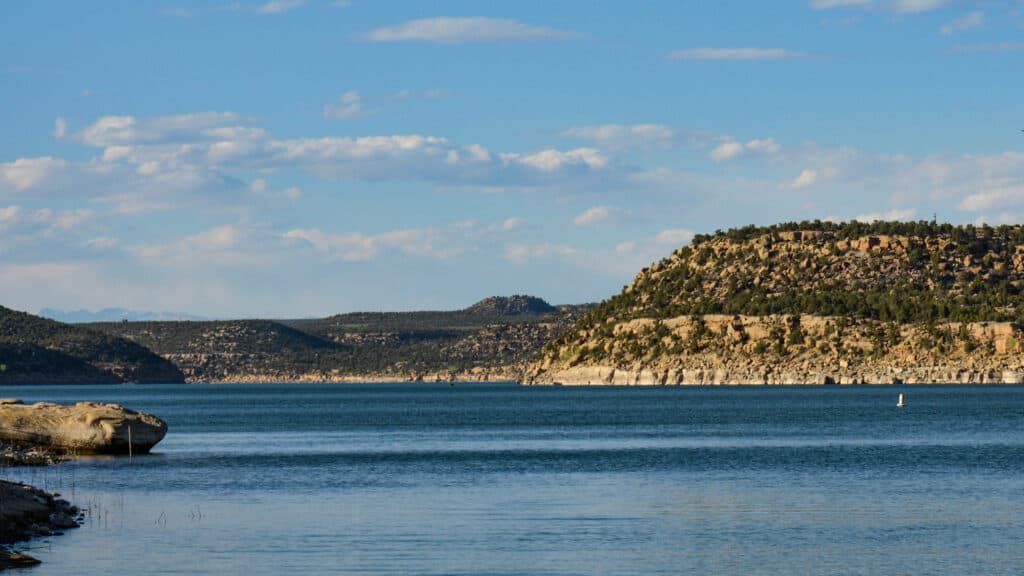
The towns of Los Arboles, Rose, Los Pinos, and Los Martinez all had to relocate. The remains of their towns are at the bottom of Navajo Lake.
©Brenda Landdeck/Shutterstock.com
Is Navajo Lake The Biggest Lake In New Mexico?
No. The biggest lake in New Mexico is Elephant Butte Lake located in south central New Mexico about 150 miles south of Albuquerque. This 57.03 square mile lake is a popular recreational lake for boating, kayaking, swimming, and fishing. There are multiple campgrounds for spending the night along the shores and exploring the nearby parks.
Elephant Butte is on the Rio Grande that runs through the heart of New Mexico. Will you find real elephants roaming the shores of the lake? No. Elephant Butte gets its name from a rock formation that looks like an elephant. “Buttes” are rock formations that are tall and flat at the top caused by erosion that sticks up from the surrounding landscape.
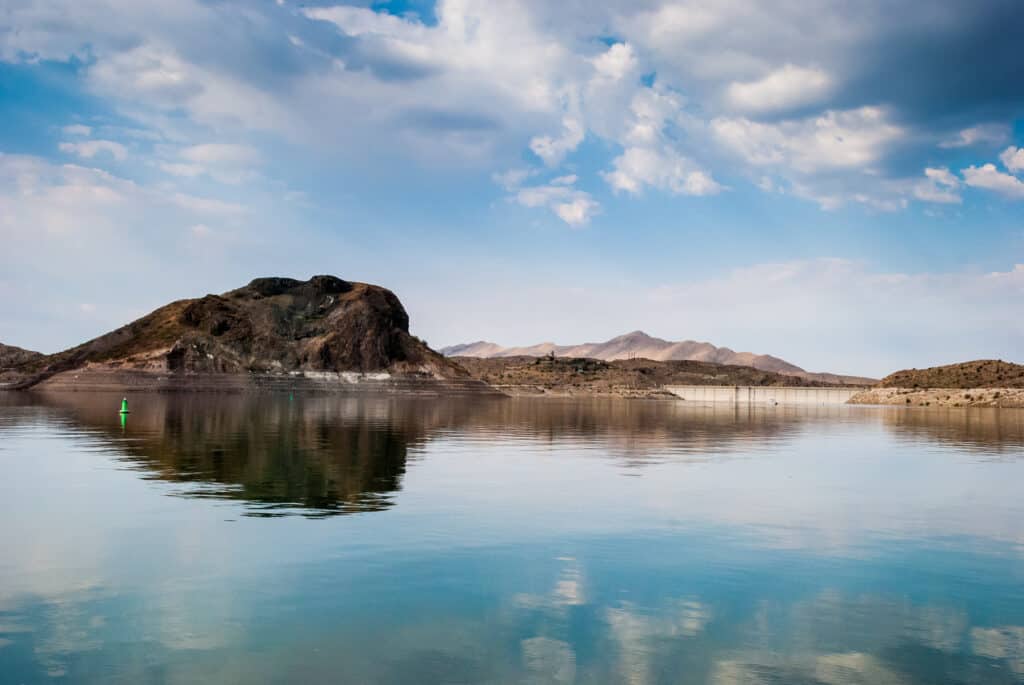
The biggest lake in New Mexico is Elephant Butte Lake, a popular recreational lake for boating, kayaking, swimming, and fishing.
©Judd Irish Bradley/Shutterstock.com
How Deep Is Elephant Butte Lake?
The deepest spot on Elephant Butte Lake is 157 feet deep. Due to recent drought conditions in the southwest states, the water levels on Elephant Butte are quite a bit lower. But beaches and boat ramps are still open and welcoming visitors to come to explore the lake and surrounding habitats.
How Is The Fishing On Lake Navajo And Elephant Butte?
The fishing is excellent on both Navajo and Elephant Butte. While you might catch your limit on Navajo you are more likely to catch a trophy-sized fish on Elephant Butte. There are multiple state records held for trophy fish from Elephant Butte. If you are into bass fishing then Elephant Butte is the place to go. There are white bass, largemouth bass, and stripers all just waiting for you.
Navajo Lake has a variety of good-sized fish including some of the best fly fishing. Come for the Kokanee salmon or try your hand at catching some feisty rainbow trout.
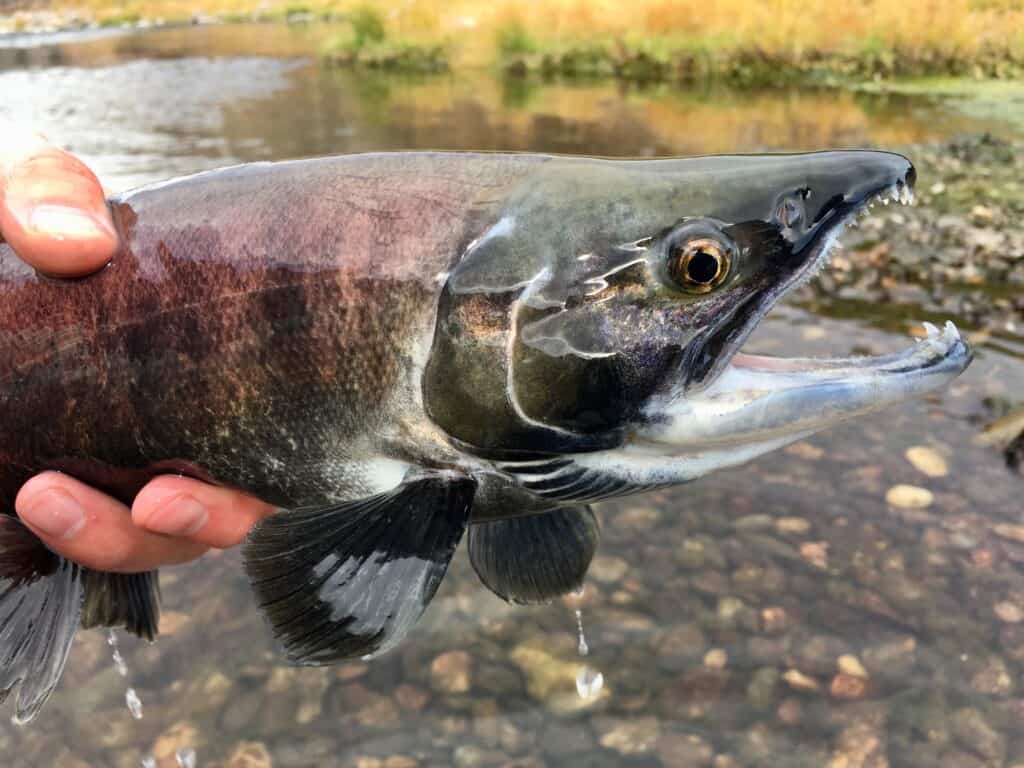
Kokanee salmon is one of the types of fish you can catch at Navajo Lake in New Mexico.
©Ryan Cuddy/Shutterstock.com
Are There Any New Mexico State Fishing Records From Lake Navajo Or Elephant Butte?
Yes! In fact, the biggest fish ever caught in New Mexico was pulled from Elephant Butte. Currently, there are no rod and reel records from Navajo Lake but there have been in the past. The biggest fish on record is a 78-pound flathead catfish that was caught by Jim Wilson back in 1979 on Elephant Butte. His catch was 47 ½ inches long, just a tad shorter than 4 feet! Now that is one big catfish.
The second and third biggest fish ever caught in New Mexico were also on Elephant Butte. The second biggest fish ever caught in New Mexico was a 54-pound 8-ounce striped bass! This giant striper was reeled in by Jim Secor back in 1992.
The third biggest fish was a 52-pound, ¼ ounce blue catfish caught by David Gower in 2005. Typically blue catfish are larger than flatheads but an older flathead may outweigh a blue cat. The record-breaking blue catfish was 43 ½ inches long, making it 3 ½ feet long, just a little longer than a baseball bat!
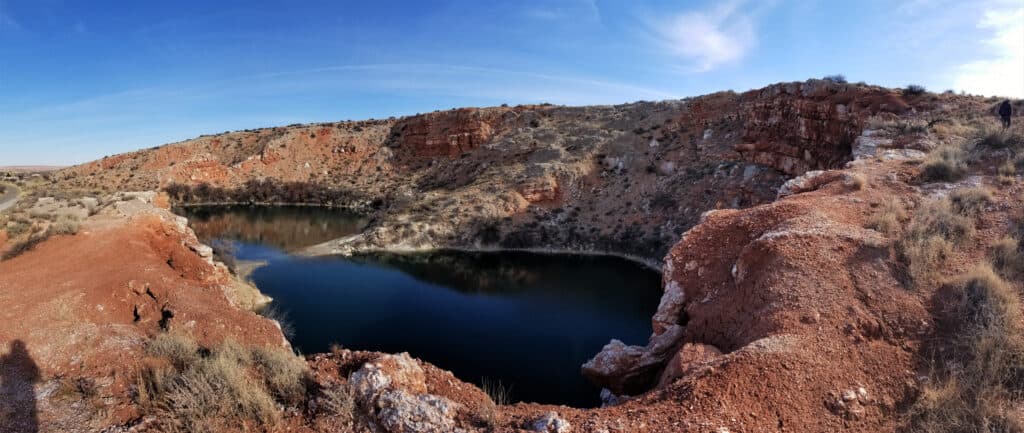
The Bottomless Lakes State Park is located around unique sinkholes that have beautiful green-blue waters.
©Trina Barnes/Shutterstock.com
What About The Bottomless Lakes In New Mexico?
Are there really bottomless lakes in New Mexico? That would definitely make them the deepest lakes in the state…or the world for that matter. There are a series of 9 lakes in New Mexico that are actually sinkholes, not lakes, that are called the “Bottomless Lakes”. The Bottomless Lakes State Park is located around these unique sinkholes that have beautiful green-blue waters.
The sinkholes seem bottomless and previous explorers tied ropes together to see just how deep the holes were but never hit bottom, thus getting the reputation for being bottomless. Today the sinkholes have been scientifically measured with some being 17 feet deep while the deepest is 90 feet deep. The deepest, Lea Lake, is also the only one that you can swim in as well as kayak, paddle board, and scuba dive.
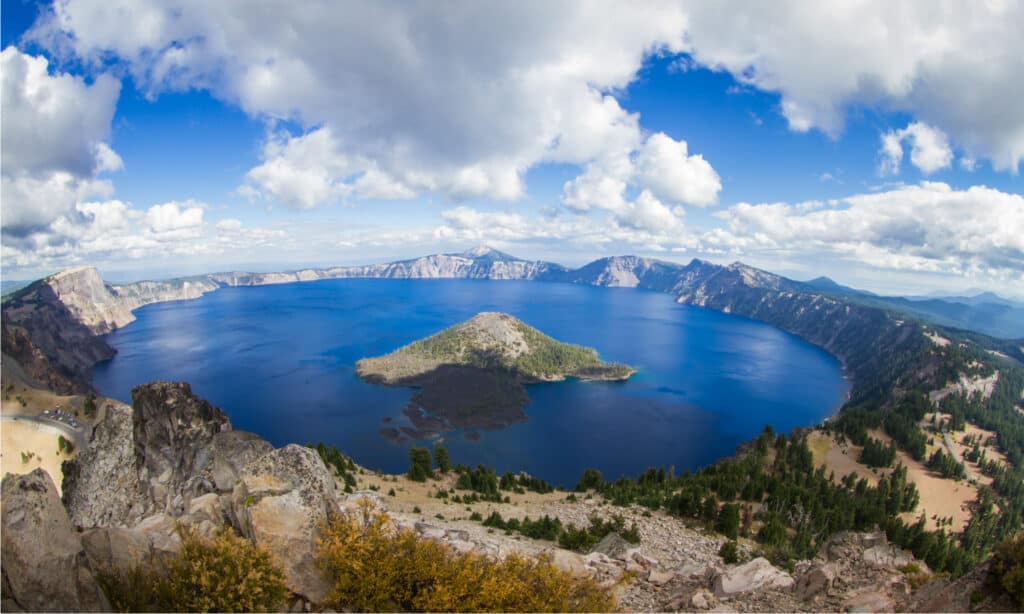
Crater Lake has the deepest lake in the United States.
©Wollertz/Shutterstock.com
How does the Deepest Lake in New Mexico Compare to the Deepest Lake in the US?
The deepest lake in New Mexico, Navajo Lake, is 395 feet deep. The deepest lake in the US is Crater Lake in Oregon, which is 1,949 feet deep, so quite a bit deeper. Crater Lake is in southern Oregon and was formed in the top of a collapsed volcano. All of the water in the lake is from either rain or snow melt so you can imagine how clear and clean the lake is!
Is there a Ghost Town Buried under Crater Lake?
No. There is not a ghost town or any civilization noted in Crater Lake. The lake was formed around 7,700 years ago when Mount Mazama, an active volcano collapsed leaving a gaping hole in the top of the volcano. This hole filled in with water from rain and snow melt creating what is Crater Lake today.
So what is in Crater Lake? Researchers have found unique tunnel formations made from aquatic moss at the bottom of Crater Lake. Some of these tunnels have thick walls of moss that are dotted with holes making them look like moldy Swiss cheese. These have been found as deep as 75-300 feet deep. Aquatic moss may not be as exciting as an underwater ghost town but standing at the edge of the deepest lake in the US and taking in the crystal blue waters is certainly an experience worth having.
The photo featured at the top of this post is © Brenda Landdeck/Shutterstock.com
Sources
- The Durango Hearald, Available here: https://www.durangoherald.com/articles/researchers-record-the-stories-of-communities-inundated-by-navajo-lake/
- EMNRD, Available here: https://www.emnrd.nm.gov/spd/find-a-park/bottomless-lakes-state-park/
- EMNRD, Available here: https://www.emnrd.nm.gov/spd/find-a-park/navajo-lake-state-park/
- National Park Service, Available here: https://www.nps.gov/crla/index.htm
Thank you for reading! Have some feedback for us? Contact the AZ Animals editorial team.






